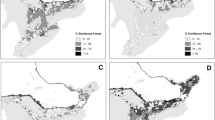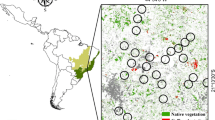Abstract
Even among forest specialists, species-specific responses to anthropogenic forest fragmentation may vary considerably. Some appear to be confined to forest interiors, and perceive a fragmented landscape as a mosaic of suitable fragments and hostile matrix. Others, however, are able to make use of matrix habitats and perceive the landscape in shades of grey rather than black-and-white. We analysed data of 42 Chiroxiphia caudata (Blue Manakin), 10 Pyriglena leucoptera (White-shouldered Fire-eye) and 19 Sclerurus scansor (Rufous-breasted Leaftosser) radio-tracked in the Atlantic Rainforest of Brazil between 2003 and 2005. We illustrate how habitat preferences may determine how species respond to or perceive the landscape structure. We compared available with used habitat to develop a species-specific preference index for each of six habitat classes. All three species preferred old forest, but relative use of other classes differed significantly. S. scansor perceived great contrast between old forest and matrix, whereas the other two species perceived greater habitat continuity. For conservation planning, our study offers three important messages: (1) some forest specialist species are able to persist in highly fragmented landscapes; (2) some forest species may be able to make use of different anthropogenic habitat types to various degrees; whereas (3) others are restricted to the remaining forest fragments. Our study suggests species most confined to forest interiors to be considered as potential umbrella species for landscape-scale conservation planning.



Similar content being viewed by others
References
Aebischer NJ, Robertson PA, Kenward RE (1993) Compositional analysis of habitat use from animal radio-tracking data. Ecology 74:1313–1325
Aitchison J (1982) The statistical analysis of compositional data. J R Statist Soc B 44:139–177
Antongiovanni M, Metzger JP (2005) Influence of matrix habitats on the occurrence of insectivorous bird species in Amazonian forest fragments. Biol Conserv 122:441–451
Báldi A (1996) Edge effects in tropical versus temperate forest bird communities: three alternative hypotheses for the explanation of differences. Acta Zoologica Academiae Scientiarum Hungaricae 42:163–172
Bélisle M (2005) Measuring landscape connectivity: the challenge of behavioral landscape ecology. Ecology 86:1988–1995
Bierregaard RO Jr, Lovejoy TE, Kapos V, dos Santos AA, Hutchings RW (1992) The biological dynamics of tropical rainforest fragments. Bioscience 42:859–866
Bissonette JA, Storch I (2002) Fragmentation: is the message clear? Cons Ecol 6:14. Available from http://www.consecol.org/vol6/iss2/art14
Boscolo D, Vielliard JME, Metzger JP (2006) Efficiency of playback for assessing the occurrence of five birds species in Brazilian Atlantic Forest fragments. An Acad Bras Cienc 78:629–644
Burnham KP, Anderson DR (2002) Model selection and multimodel inference: a practical information-theoretic approach, 2nd edn. Springer, New York
Canaday C (1997) Loss of insectivorous birds along a gradient of human impact in Amazonia. Biol Conserv 77:63–77
Catharino EL, Bernacci LC, Franco GADC, Durigan G, Metzger JP (2006) Aspectos da composição e diversidade do componente arbóreo das florestas da Reserva Florestal do Morro Grande, Cotia, SP. Biota Neotropical 6(2). Available from http://www.biotaneotropica.org.br/v6n2/pt/abstract?article+bn00306022006
Debinski DM, Holt RD (2000) A survey and overview of habitat fragmentation experiments. Conserv Biol 14:342–355
Develey PF, Metzger JP (2006) Emerging threats to birds in Brazilian Atlantic forests: the roles of forest loss and configuration in a severely fragmented ecosystem. In: Laurance WF, Peres CA (eds) Emerging threats to tropical forests. University of Chicago Press, Chicago, pp 269–290
Develey PF, Stouffer PC (2001) Effects of roads on movements by understory birds in mixed-species flocks in Central Amazonian Brazil. Conserv Biol 15:1416–1422
Durigan G, Bernacci LC, Franco GADC, Arbocz G, Metzger JP, Catharino EL (2008) Estádio sucessional e fatores geográficos como determinantes da similaridade florística entre fragmentos florestais no Planalto Atlântico, Estado de São Paulo, Brasil. Acta Botânica Brasílica 22:51–62
Faaborg J, Brittingham M, Donovan T, Blake J (1995) Habitat fragmentation in the temperate zone. In: Martin TE, Finch DM (eds) Ecology and management of neotropical migratory birds. Oxford University Press, Oxford, pp 357–380
Farina A (1998) Principles and methods in landscape ecology. Kluwer, Dordrecht
Fischer J, Lindenmayer DB (2006) Beyond fragmentation: the continuum model for fauna research and conservation in human-modified landscapes. Oikos 112:473–480
Freemark KE, Dunning JB, Hejl SJ, Probst JR (1995) A landscape ecology perspective for research, conservation, and management. In: Martin TE, Finch DM (eds) Ecology and management of neotropical migratory birds. Oxford University Press, Oxford, pp 381–427
Gascon C, Lovejoy TE, Bierregaard RO, Malcom JR, Stouffer PC, Vasconcelos H, Laurance WF, Zimmerman B, Tocher M, Borges S (1999) Matrix habitat and species persistence in tropical forest remnants. Biol Conserv 91:223–229
Gillies CS, Clair CCS (2008) Riparian corridors enhance movement of a forest specialist bird in fragmented tropical forest. Proc Nat Acad Sci 105:19774–19779
Hansbauer MM, Storch I, Leu S, Nieto-Holguin JP, Pimentel RG, Knauer F, Metzger JP (2008a) Movements of neotropical understory passerines affected by anthropogenic forest edges in the Brazilian Atlantic rainforest. Biol Conserv 141:782–791
Hansbauer MM, Storch I, Pimentel RG, Metzger JP (2008b) Comparative range use by three Atlantic Forest understorey bird species in relation to forest fragmentation. J Trop Ecol 24:291–299
Hilton-Taylor C (compiler) (2000) 2000 IUCN red list of threatened species. IUCN, Gland, Switzerland and Cambridge
Kenward R (2001) A manual for wildlife radio tagging. Academic Press, London
Kneib T, Knauer F, Küchenhoff H (2009) A general approach to the analysis of habitat selection. Environ Ecol Stat (in press)
Lampila P, Mönkkönen M, Desrochers A (2005) Demographic responses by birds to forest fragmentation. Conserv Biol 19:1537–1546
Lovejoy TE, Bierregaard RO Jr, Rylands AB, Malcolm JB, Quintela C, Harper LH, Brown KS Jr, Powell AH, Powell GBN, Schubart HOR, Hays MB (1986) Edge and other effects of isolation on Amazon forest fragments. In: Soulé MA (ed) Conservation biology. The science of scarcity and diversity. Sinauer, Sunderland, pp 257–285
Marini MA, Garcia FI (2005) Bird conservation in Brazil. Conserv Biol 19:665–671
Martensen AC, Pimentel RG, Metzger JP (2008) Relative effects of fragment size and connectivity on bird community in the Atlantic Rain Forest: implications for conservation. Biol Conserv 141:2184–2192
McGarigal K, Cushman SA (2005) The gradient concept of landscape structure. In: Wiens JA, Moss MR (eds) Issues and perspectives in landscape ecology. Cambridge University Press, Cambridge, pp 112–119
Metzger JP (2006) How to deal with non-obvious rules for biodiversity conservation in fragmented areas. Braz J Nat Conserv 4:125–137
Metzger JP (2009) Conservation issues in the Brazilian Atlantic Forest. Biol Conserv 142:1138–1140
Metzger JP, Simonetti C, Uezu A, Diederichsen A, Goulart W (2002) Estrutura da paisagem em Caucaia do Alto (Planalto de Ibiúna, SP). In: Metzger JP (ed) Conservação da biodiversidade em paisagens fragmentadas no Planalto Atlântico de São Paulo. FAPESP 99/05123-4 technical report n. 2, Anexo 1. São Paulo, Brazil
Metzger JP, Simonetti C, Uezu A, Diederichsen A, Goulart W (2003) Estrutura da paisagem em Caucaia do Alto (Planalto de Ibiúna, SP). In: Metzger JP (ed) Conservação da biodiversidade em paisagens fragmentadas no Planalto Atlântico de São Paulo. FAPESP 99/02123-4 technical report n. 3, Anexo 1. São Paulo, Brazil
Metzger JP, Alves LF, Pardini R, Dixo M, do Amaral Nogueira A, Negrão MFF, Martensen AC, Catharino ELM (2006) Características ecológicas e implicações para a conservação da Reserva Florestal do Morro Grande. Biota Neotropica 6 (2). Available from http://www.biotaneotropica.org.br/v6n2/pt/abstract?article+bn01006022006
Myers N, Mittermeier RA, Mittermeier CG, da Fonseca GAB, Kent J (2000) Biodiversity hotspots for conservation priorities. Nature 403:853–858
Oppel S, Schaefer HM, Schmidt V, Schröder B (2004) Habitat selection by the pale-headed brush-finch (Atlapetes pallidiceps) in southern Ecuador: implications for conservation. Biol Conserv 118:33–40
Perfecto I, Vandermeer J (2002) Quality of agroecological matrix in a tropical montane landscape: ants in coffee plantations in southern Mexico. Conserv Biol 16:174–182
Ribeiro MC, Metzger JP, Martensen AC, Ponzoni F, Hirota M (2009) Brazilian Atlantic forest: how much is left and how is the remaining forest distributed? Implications for conservation. Biol Conserv 142:1141–1153
SABESP (1997) Programa de conservação do sistema Cotia. Relatório conclusivo (tomo 3): Avaliação Ambiental. SABESP/Fundação Brasileira para o Desenvolvimento Sustentável, São Paulo
Seabra M (1971) Vargem Grande: Organização e transformação de um setor do cinturão paulistano. USP, Instituto de Geografia, São Paulo
Sick H (1997) Ornitologia Brasileira. Ed. Nova Fronteira, Rio de Janeiro
Sieving KE, Willson MF, De Santo TL (1996) Habitat barriers to movement of understory birds in fragmented south-temperate rainforest. Auk 113:944–949
Silva WGS, Metzger JP, Simões S, Simonetti C (2007) Relief influence on the spatial distribution of the Atlantic Forest cover at the Ibiúna Plateau, SP. Braz J Biol 67:403–411
Skutch AF (1996) Antbirds and ovenbirds. University of Texas Press, Austin
Snow DW (1976) The web of adaptation. Quadrangle. The New York Times Book Co, New York
Teixeira AMG, Soares-Filho BS, Freitas SR, Metzger JP (2009) Modeling landscape dynamics in an Atlantic Rainforest region: implications for conservation. For Ecol Manag 257:1219–1230
Terborgh J (1992) Maintenance of diversity in tropical forests. Biotropica 24:283–292
Thomas JW, Forsman ED, Lint JB, Meslow EC, Noon BR, Verner J (1990) A conservation strategy for the Northern Spotted Owl: interagency committee to address the conservation of the Northern Spotted Owl. US Department of Agriculture, Portland
Turner IM (1996) Species loss in fragments of tropical rain forest: a review of the evidence. J Appl Ecol 33:200–209
Uezu A (2002) Efeito do tamanho de fragmentos e da conectividade na abundância de 7 espécies de aves florestais em Caucaia do Alto, São Paulo, Brasil. Msc thesis, University São Paulo
Uezu A, Metzger JP, Vielliard JME (2005) Effects of structural and functional connectivity and patch size on the abundance of seven Atlantic Forest bird species. Biol Conserv 123:507–519
Umetsu F, Pardini R (2007) Small mammals in a mosaic of forest remnants and anthropogenic habitats–evaluating matrix quality in an Atlantic forest landscape. Landscape Ecol 22:517–530
Umetsu F, Metzger JP, Pardini R (2008) Importance of estimating matrix quality for modeling species distribution in complex tropical landscapes: a test with Atlantic forest small mammals. Ecography 31:359–370
Vos CC, Verboom J, Opdam PFM, Ter Braak CJF (2001) Toward ecologically scaled landscape indices. Am Nat 183:24–41
Wiens JA, Schooley RL, Weeks RD Jr (1997) Patchy landscapes and animal movements: do beetles percolate? Oikos 78:257–264
Willis EO (1979) The composition of avian communities in remanescent woodlots in southern Brazil. Papéis Avulsos de Zoologia 33:1–25
With KA (1994) Using fractal analysis to assess how species perceive landscape structure. Landscape Ecol 9:25–36
Acknowledgments
This study was supported by the German BMBF (Federal Ministry of Education and Research) that financed the program BIOCAPSP within the framework of the Brazilian-German cooperation “Mata Atlântica” (Förderkennzeichen 01LB0202 (Teilprojekt D3)), and by the Brazilian Council for Research and Technology (CNPq) (Project ‘Biodiversity conservation in fragmented landscapes on the Atlantic Plateau of São Paulo’, No. 590041/2006-1). We especially thank all our committed and patient field helpers for their invaluable help and their mental input. R. Iartelli arranged the catching permits and Leandro Tambosi digitized the aerial photographs of the northern part of the study area. For their valuable comments on the manuscript we thank Eric Gustafson and two anonymous reviewers.
Author information
Authors and Affiliations
Corresponding author
Rights and permissions
About this article
Cite this article
Hansbauer, M.M., Storch, I., Knauer, F. et al. Landscape perception by forest understory birds in the Atlantic Rainforest: black-and-white versus shades of grey. Landscape Ecol 25, 407–417 (2010). https://doi.org/10.1007/s10980-009-9418-9
Received:
Accepted:
Published:
Issue Date:
DOI: https://doi.org/10.1007/s10980-009-9418-9




